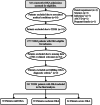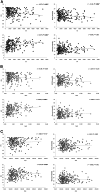Association of the systemic immune-inflammation index (SII) and severity of diabetic ketoacidosis in patients with type 1 diabetes mellitus: a retrospective cohort study
- PMID: 38989212
- PMCID: PMC11230746
- DOI: 10.1097/MS9.0000000000002185
Association of the systemic immune-inflammation index (SII) and severity of diabetic ketoacidosis in patients with type 1 diabetes mellitus: a retrospective cohort study
Abstract
Background: Diabetic ketoacidosis (DKA) is the most serious metabolic complication of type 1 diabetes mellitus (T1DM). Insulin deficiency and inflammation play a role in the pathogenesis of DKA. The authors aimed to assess the systemic immune-inflammation index (SII) as a marker of severity among T1DM patients with DKA and without infection.
Methods: The authors included T1DM patients older than or equal to 12 years hospitalized because of DKA. The authors excluded patients with infection or any condition that can change SII parameters or cause metabolic acidosis. The authors compared SII, neutrophil-lymphocyte ratio (NLR), and platelet-lymphocyte ratio (PLR) between severe and non-severe DKA groups. The authors also assessed the need for an ICU, length of stay, and 90-day readmission rate between the groups.
Results: The study included 241 patients with a median age of 17 (14, 24) years, and 44.8% were males. More patients with severe DKA (45%) required ICU admission (P<0.001). Median SII increased with DKA severity, and the difference was significant (P=0.033). No significant difference was observed as regards median NLR or PLR (P=0.380 and 0.852, respectively). SII, but not NLR or PLR, had a significant negative correlation with PH (r=-0.197, P=0.002) and HCO3 level (r=-0.144, P=0.026). Also, being in the highest SII quartile was an independent risk factor for DKA severity (OR, 2.522; 95% CI, 1.063-6.08; P=0.037). The authors estimated an SII cut-off value of 2524.24 to predict DKA severity with high specificity.
Conclusion: Elevated SII is a risk factor for DKA severity in T1DM. It is better than NLR and PLR in prognosticating DKA patients. These findings highlight the role of inflammation in DKA. SII can help as a valuable and simple tool to assess DKA severity.
Keywords: complete blood count; diabetes mellitus; diabetic ketoacidosis; neutrophil-lymphocyte ratio; platelet-lymphocyte ratio; systemic immune-inflammation index.
Copyright © 2024 The Author(s). Published by Wolters Kluwer Health, Inc.
Conflict of interest statement
The authors declare no conflicts of interest.Sponsorships or competing interests that may be relevant to content are disclosed at the end of this article.
Figures



Similar articles
-
Systemic immune-inflammation index, neutrophil-to-lymphocyte ratio, and platelet-to-lymphocyte ratio in patients with type 2 diabetes at different stages of diabetic retinopathy.Int J Ophthalmol. 2024 May 18;17(5):877-882. doi: 10.18240/ijo.2024.05.12. eCollection 2024. Int J Ophthalmol. 2024. PMID: 38766329 Free PMC article.
-
Neutrophil-to-Lymphocyte Ratio Adds Valuable Information Regarding the Presence of DKA in Children with New-Onset T1DM.J Clin Med. 2022 Dec 28;12(1):221. doi: 10.3390/jcm12010221. J Clin Med. 2022. PMID: 36615022 Free PMC article.
-
The clinical value of neutrophil-to-lymphocyte ratio (NLR), systemic immune-inflammation index (SII), platelet-to-lymphocyte ratio (PLR) and systemic inflammation response index (SIRI) for predicting the occurrence and severity of pneumonia in patients with intracerebral hemorrhage.Front Immunol. 2023 Feb 13;14:1115031. doi: 10.3389/fimmu.2023.1115031. eCollection 2023. Front Immunol. 2023. PMID: 36860868 Free PMC article.
-
The correlation of systemic immune-inflammation index, neutrophil-to-lymphocyte ratio, derived neutrophil-to-lymphocyte ratio, and platelet-to-lymphocyte ratio with disease severity in recurrent aphthous stomatitis.J Cosmet Dermatol. 2022 Oct;21(10):4858-4863. doi: 10.1111/jocd.14838. Epub 2022 Feb 18. J Cosmet Dermatol. 2022. PMID: 35150041
-
The values of systemic immune-inflammation index and neutrophil-lymphocyte ratio in predicting testicular germ cell tumors: A retrospective clinical study.Front Oncol. 2022 Sep 16;12:893877. doi: 10.3389/fonc.2022.893877. eCollection 2022. Front Oncol. 2022. PMID: 36185298 Free PMC article.
Cited by
-
Predictive Value of Preoperative Fibrinogen and Albumin Score (FA Score) for Prognosis and Chemotherapeutic Efficacy in Resected Colorectal Cancer: A Retrospective Cohort Study.J Cancer. 2024 Sep 23;15(18):5968-5977. doi: 10.7150/jca.100674. eCollection 2024. J Cancer. 2024. PMID: 39440062 Free PMC article.
-
Elevated Leukocyte Glucose Index (LGI) Is Associated with Diabetic Ketoacidosis (DKA) Severity and Presence of Microvascular Complications.Medicina (Kaunas). 2025 May 15;61(5):898. doi: 10.3390/medicina61050898. Medicina (Kaunas). 2025. PMID: 40428856 Free PMC article.
-
Differential expression of plasma proteins and pathway enrichments in pediatric diabetic ketoacidosis.Mol Med. 2025 Jan 7;31(1):4. doi: 10.1186/s10020-024-01056-7. Mol Med. 2025. PMID: 39773407 Free PMC article.
References
-
- Dhatariya KK, Glaser NS, Codner E, et al. . Diabetic ketoacidosis. Nat Rev Dis Primer 2020;6:40. - PubMed
-
- Dhatariya KK, The Joint British Diabetes Societies for Inpatient Care . The management of diabetic ketoacidosis in adults—an updated guideline from the Joint British Diabetes Society for Inpatient Care. Diabet Med 2022;39:e14788. - PubMed
-
- Glaser N, Fritsch M, Priyambada L, et al. . ISPAD Clinical Practice Consensus Guidelines 2022: Diabetic ketoacidosis and hyperglycemic hyperosmolar state. Pediatr Diabetes 2022;23:835–856. - PubMed
-
- Close TE, Cepinskas G, Omatsu T, et al. . Diabetic ketoacidosis elicits systemic inflammation associated with cerebrovascular endothelial cell dysfunction. Microcirculation 2013;20:534–543. - PubMed
LinkOut - more resources
Full Text Sources
